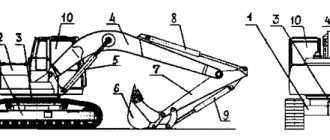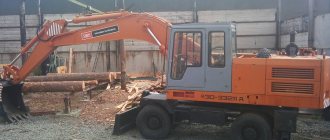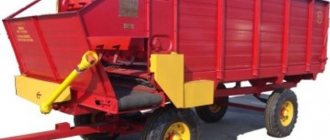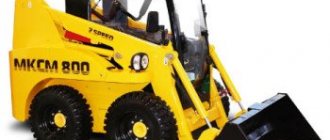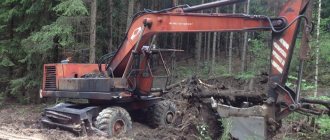Universal hydraulic excavator EO-4321B description and technical characteristics
In 1988, Kyiv mastered the serial production of the modernized single-bucket universal hydraulic excavator EO-4321B on pneumatic wheels. The EO-4321B excavator is designed for excavation and loading and unloading operations in urban, industrial, rural and transport construction. An excavator can be used to develop unfrozen soils of categories I - IV, loosen frozen soils, destroy asphalt concrete pavements, load bulk materials and pre-loosened rocks into vehicles, as well as perform planning and other work. The main tasks when modernizing a basic excavator are to further increase the machine’s productivity, reduce the specific material and energy consumption, increase the service life and improve the design of assembly units, and improve the working conditions of the driver. For this purpose, the following main design improvements were made on the EO-4321B excavator (compared to the EO-4321A excavator): an SMD-17N engine with a power of 74 kW was used instead of a SMD-15N engine with a power of 59 kW; a backhoe bucket with a nominal capacity of 1 m3 is installed, which has crescent-shaped side cutting edges and an additional hole for attaching the rod in order to increase the soil cutting force and improve the conditions for filling the bucket when working at maximum digging depth. This bucket can be used on heavy soils up to category IV inclusive; a bucket hydraulic cylinder with a piston of increased diameter was used to increase the cutting force from 120 to 150 kN; the boom, handle and bucket of the backhoe with a reinforced design were installed in order to increase the reliability and durability of the basic elements of the working equipment; a new running gear with a modified frame was introduced (AS 1229274 USSR) to increase the reliability and stability of the excavator, as well as to reduce its width from 3.1 to 2.84 m; effective changes were made to the design of the central manifold of the hydraulic system and to the valve and safety equipment; to increase the service life of hydraulic system assembly units, a new filter with paper filter elements of the “Regotmas” type was installed; to ensure safety conditions, changes were made to the pneumatic system, which increased its performance: the braking distance was reduced from 9 to 6 - 7 m; The design of the cabin and service areas was changed, which significantly improved the driver’s working conditions. As a result of modernization, the technical performance of the EO-4321B excavator has significantly increased. The replaceable working equipment and working parts of the EO-4321B excavator include a backhoe with four buckets, a straight shovel with two buckets, a grab with an extension and narrow jaws, gripper jaws, narrow buckets with a capacity of 0.5 m3 and a cleaning bucket (1 m3), two profile buckets (1 m3 each) with a slope angle of 30 and 45°, a hydraulic hammer, a ripper tooth, a hook suspension. To change the operating parameters, two booms and two handles of different lengths have been developed.
Technical characteristics of the EO-4321B excavator
| Operating weight with backhoe equipment, t | 19,5 |
| Engine power, kW | 74 |
| Maximum transport speed, km/h | 20 |
| Overcome slope of hard dry path, degrees. | 22 |
| Overall dimensions in transport position, mm | 9900 X 2840 X 3990 |
| Number of types of working equipment and working bodies | 21 |
Backhoe
| Geometric (nominal) bucket capacity, m3 | 0.8 (1) | 0,63 (0,72) | 1 (1,23) | 1,25 (1,51) |
| Maximum digging depth, m | 5,5 | 6 | 4,31 | 4,51 |
| Maximum digging radius at parking level, m | 8,9 | 9,23 | 7,52 | 7,83 |
| Maximum unloading height, m | 5,5 | 5,51 | 4,52 | 4,51 |
| Digging force, kN | 150 | 143 | 140,7 | 120 |
Direct digging equipment
| Digging bucket capacity, m3 | 1 (1,2) | |
| Loading bucket capacity, m3 | 1,6 | |
| Maximum digging height, m | 7,9 | — |
| Maximum digging radius, m | 7,8 | — |
| Maximum unloading height, m | 4,7 | 4,4 |
Grab
| Bucket capacity, m3 | 0,65 | 0,65 | 0.25 (with extension) |
| Maximum digging depth, m | 7,3 | 10,5 | 7,2 |
| Maximum digging radius, m | 9,2 | 8,6 | 9,1 |
| Maximum unloading height, m | 3,3 | 0,9 | 3,4 |
Hook suspension
| Load capacity at maximum reach, t | 2 |
| Load capacity with handle tucked, t | 4,5 |
| Maximum lifting height of the hook, m | 6,2 |
Hydraulic hammer GPM-300L
| Effective power, kW | 9,17 |
| Maximum energy of the impact part, kJ | 3,1 |
| Impact frequency, Hz | 2,96 |
During testing, the EO-4321B excavator excavated 33.63 thousand m3 of soil. For pure operating time on soils of categories I – IV, the productivity of the machine with backhoe equipment and buckets with a capacity of 0.63; 0.8; 1 and 1.25 m3 varied from 108.9 to 229.3 m3/h. Positive results were obtained when testing other types of replaceable working equipment and working parts. The estimated annual operational productivity of the EO-4321B excavator is 119.35 thousand m3, which is 16% more than that of the replaced model of the EO-4321A excavator.
Engineers V.V. OLEKSENKO, V.A. BOYCHENKO (PO "Red Excavator") and Ph.D. tech. Sciences A. V. RANNEV (NPO “VNIIStroydormash”) Data and photographs from the magazine “Construction and Road Machines” No. 11.1988.
Scope of application and features of the model
"EO-4321", the bucket of which could hold 1-1.2 cubic meters of soil, was intended for excavation and loading/unloading work in urban, industrial, rural and transport construction. His field of activity is the development of unfrozen soils of categories I - IV; loosening frozen soils; destruction of old asphalt concrete pavements; loading of bulk materials and pre-loosened rocks into dump trucks; providing planning work on the ground.
The excavator has a strong and durable design, all elements of which are made of high-strength steel. The frame is rigid welded, with installed hydraulic outriggers and bulldozer equipment at the front. The chassis is a steered pneumatic wheel, with wide-profile tires and a rear driven axle, and a front steered axle. The rotating platform is equipped with a hydraulic system, a 320-liter tank, a dual axial piston pump, and a safety system with safety valves that maintain pressure in the working cavities up to 320 MPa.
The versatility of "EO-4321". Working equipment and replacement parts
The replaceable working equipment and replaceable parts “EO-4321” include several shovels, a grab with an extension and narrow jaws, jaws, several different buckets, a hydraulic hammer, a ripper tooth and a hook suspension. This ensures the versatility of this machine.
To develop different types of soil and successfully perform different tasks, the excavator can be equipped with a normal or extended type of handle, or with an offset upper part of the boom. To destroy hard asphalt concrete pavement or frozen soil, “EO-4321” can be equipped with a ripper tooth and a hydraulic hammer. The excavator's performance during loosening is 50 cubic meters per hour.
The excavator also demonstrates decent performance with mounted drilling equipment. To dig pits, grab equipment with a two-jaw bucket with a capacity of 0.65 cubic meters is mounted on the machine. m with a change in the angle of inclination to the surface. This expansion of the range of replaceable working equipment used is ensured by the presence of a reliable hydraulic drive.
About the history of the model and the enterprise
Kiev Excavator Plant is one of the oldest machine-building enterprises in our country. It was founded in 1898 as a plant for the production of seeders and other agricultural machinery. Many workers of this plant took part in revolutionary activities, and after 1917 actively participated in the establishment of Soviet power. Since 1918.
The first excavator, a multi-bucket quarry excavator, model MK-1, was produced by the plant in 1934. In 1935, the enterprise changed its specialization, finally moving from the production of agricultural machinery to the production of excavators, and began to be called “Red Excavator”.
After the start of the Great Patriotic War, the plant was evacuated to Western Siberia, but immediately after the liberation of Kyiv from the Nazis, restoration of the enterprise began. The first hydraulic excavator in the history of the USSR was produced here, in 1955, and in subsequent years the plant was reoriented to the production of just such equipment.
After the collapse of the Soviet Union, the plant became known as Atek. It regularly announced and promoted the release of new, more modern models of excavators, but in reality it fell into decay, its powerful material and technical base was squandered and stolen. The plant experienced several bankruptcies, raider attacks - “mask shows” by police officers and “armed men in uniform.”
Since December 2014, a training base for the nationalist Azov regiment has been located on the territory of the plant, and the remaining property is dismantled and transported for scrap metal and construction materials. The latest product was the only example of the double-turret (!) Azovets tank, made from a bulldozer based on the T-64 tank.
Modifications of the excavator "EO-4321"
The basic model of the excavator – “EO-4321” – was produced from 1972 to 1983. Its distinctive features are monoblock outriggers, non-monoblock boom, SMD-14 engine (80 hp). The width of the excavator was 2.84 m.
The first modernization of the excavator was carried out in 1983. It consisted of improving hydraulics and increasing the working volume of a standard backhoe (0.63 versus 0.5 m3). The new version - "EO-4321A" - also received a new boom and handle, 3.15 m long instead of 2.93 m on the base model. The digging depth also increased: it was 6 meters, with a turning radius of 9.3 m. The maximum unloading height also increased by 10 cm. The parameters have changed similarly for all types of spare parts for excavators.
A new frame with increased stability was developed for the EO-4321A. These developments were the result of specific practical experience in operating the excavator. In particular, the hydraulics were modified, so to speak, “at the request of the workers,” because the hoses often did not reach the end of their service life, but began to leak soon after the excavator began operating. Now the hydraulic system has become more reliable, equipped with working hoses with a long service life.
It is unrealistic to meet “EO-4321A” on the streets of a modern city, given the current traffic congestion. Because the increased stability frame increased the width of the excavator in this modification to 3.10 meters. Which is unacceptable according to modern requirements for road dimensions (after 2.5 m you need a special permit, and after 3 meters you need a traffic police vehicle for escort). In this regard, such a modification can only be seen in any quarry where there are no restrictions on movement dimensions.
"EO-4321A" was awarded a Gold Medal at the Exhibition of Achievements of the National Economy in Moscow.
The result of the next modernization of the excavator was the launch of the EO-4321B . The years of its release are from 1988 to 1990. This modification differs from previous models by a more powerful engine - “SMD-17N”, instead of “SMD-15N”. A monoblock boom (bent), non-monoblock outriggers (the plate moves relative to the handle) also appeared; a different instrument panel and levers were installed in the cockpit. The rotating frame was strengthened and made stronger. Operating experience showed that the frame sometimes could not withstand overloads and burst in front of the ring on which the turntable was attached. We had to weld the rail into the base of the frame to strengthen it.
The new enlarged backhoe bucket with a nominal capacity of 1 m3 received crescent-shaped side cutting edges and an additional hole for attaching the rod in order to increase the soil cutting force and improve the conditions for filling the bucket when working at maximum digging depth.
The length of the new modification of the excavator decreased by 26 cm, and they also got rid of the oversized width - on the EO-4321B it became 2.84 meters versus 3.10. The new bucket can be used on heavy soils up to category IV inclusive; a bucket hydraulic cylinder with a piston of increased diameter was introduced to increase the cutting force from 120 to 150 kN; the boom, handle and bucket of the backhoe with a reinforced design were installed in order to increase the reliability and durability of the basic elements of the working equipment; a new running gear was introduced along with a modified frame.
Effective changes were made to the design of the central hydraulic system manifold and to the valve and safety equipment; to increase the service life of hydraulic system assembly units, a new filter with paper filter elements of the “Regotmas” type was installed; To ensure safety conditions, changes were made to the pneumatic system that increased its performance: the braking distance was reduced from 9 to 6 -7 m; The design of the cabin and service areas was changed, which significantly improved the driver’s working conditions.
The estimated annual operational productivity of the EO-4321B excavator was 119.35 thousand m3, which is 16% more than that of the previous modification of the excavator, EO-4321A.
And finally, “EO-4321V” (aka “Atek-881” according to the new indexing system of the Kiev Excavator Plant). The only difference between modification “B” and “B” is a different hydraulic motor for turning the platform. On the “EO-4321B” the hydraulic motor was located at the very bottom of the platform, directly on the slewing bearing itself, and on the “EO-4321B” they installed a different hydraulic motor of an improved design, which was significantly smaller in size than its predecessor. And they mounted it at the top of the platform, and in such a way that they had to make a small slot in the roof under its upper part.
Advantages and disadvantages
The versatility of the machine was that the necessary equipment for work could be attached to the hydraulic attachment system, and then removed. The backhoe can be changed. There are several of them, of different capacities. In addition, this main working tool could be disconnected and replaced with a grab, jaw-grippers, a slotting hammer, and a ripper tooth. The machine operates in 40% frost (with non-icy soils) and 40% heat. It should be noted that the excavator is economical and efficient. Despite its many advantages, this machine had disadvantages . During long-term maintenance, hydraulic hoses begin to leak. If worked with too much force, the swing frame could burst.
Excavator EO 4321 at work
The model of the fourth group of specialized equipment worked (and continues to work) in agriculture, transport, and construction. In the army, the machine was previously used in technical troops. But the technical characteristics of the EO 4321 were inferior to Western machines of this type. Therefore, in 1983 the car was modernized and the “A” model began to be produced. The engine was left the same, but the volume of the backhoe was increased. Improved hydraulics. 3 years after the start of production, in 1986, model “A” was discontinued. The production of EO 4321B, an even more improved machine, began. It was very different in its characteristics from the previous two models. The engine was replaced, the shovels were improved, the rotating frame was made stronger so that it would not break under overload.
Be sure to read: Excavator EO 4121: technical specifications
But, since even the improved machine was inferior to similar Western technology, EO-4322 began to be produced in 1989. After the collapse of the Union, the Kiev company was renamed JSC Atek. Model EO-4322 has been modernized. Atek 4321 began to be produced, according to the nomenclature classification of the renamed plant, and so it is considered as model 4321B, because it absolutely repeats all the characteristics of the car of the 80s. The only difference from the previous model is that they made a different diesel engine, and the hydraulic motor is installed at the top of the platform, and not at the bottom. This excavator was produced throughout the 90s. It can be recognized by the characteristic yellow and red color of the coating. Now the release of this car is in doubt. The bankrupt plant has not been operating for several years. And the famous excavators of the 70s and 80s can be bought used. They are still working successfully throughout the territory of the former Union, including in Russia. Now the Russian EK-18 is an analogue of this machine.
Design of the excavator "EO-4321"
The main components in the design of the EO-4321 excavator are: working equipment (boom and elements connecting the bucket to the boom, buckets, etc.), power plant (diesel engine "SMD" with hydraulic pump), chassis with pneumatic wheels, transmission mechanism, transmission platform and hydraulic system, electrical equipment and cabin with controls.
Working equipment
Buckets: a backhoe with four buckets, a straight shovel with two buckets, a grab with an extension and narrow jaws, gripper jaws, narrow buckets with a capacity of 0.5 m3 and a cleaning bucket - 1 m3, two profile buckets of 1 m3 each with a slope angle of 30 and 45 °. In addition to buckets, the replaceable equipment of this excavator includes a hydraulic hammer, ripper tooth and crane hook suspension. To change operating parameters, it is possible to install booms and handles of different lengths.
On the working platform, which rests on the chassis frame with the help of a roller slewing device, there are mounted working equipment, an SMD diesel engine, a fuel tank, a hydraulic fluid tank, a cabin with a control panel, switchgear, a container with batteries, a high-torque radial - piston hydraulic motor for turning.
Chassis
The chassis of the EO-4321 excavator includes a profile bent frame, front steered and rear drive axles, and a steering mechanism for the front axle wheels (using a hydraulic drive). The front axle of the excavator is suspended in front of the frame on special hinges.
The excavator is equipped with a non-mechanical transmission with a final drive in the form of bevel planetary gearboxes. Due to the fact that the force on the wheels is supplied directly from the hydraulic motor, the process is significantly accelerated.
The supercharging and braking system of the EO-4321 excavator operates from a pneumatic drive. The excavator is equipped with wide-profile pneumatic tires (1300 (530-533) mm).
The hydraulic system of the equipment is installed on a turntable and includes a dual axial piston pump, safety and distribution valve equipment, a hydraulic turn drive and a tank. The pressure in the hydraulic system is maintained at 320 MPa.
The working equipment is fixed in the front part of the turntable; a counterweight is installed on its rear part. The basic element of the working equipment is a boom, which is connected with fingers to an insert that regulates its reach. When a front shovel is installed, the backhoe boom insert is replaced with a straight shovel boom insert. The EO-4321 excavator is equipped with bulldozer equipment (in front) and outriggers (on the rear beam). These supports are hydraulically driven.
Hydraulic system
The working mechanisms of the excavator are hydraulically driven. The hydraulic system includes an oil tank, hydraulic pumps, control and measuring equipment, working fluid filtration equipment, actuators, a servo control system, a steering hydraulic system, pipelines and a working fluid cooling system.
In combination with hydraulic servo control, the excavator's hydraulic drive provides speed control and combination of the working movements of the boom, handle and bucket with rotation.
Excavator performance characteristics
The first excavator EO 4321, with a total weight of 19.8 tons, rolled off the factory assembly line in 1972. It was equipped with an SMD-15N engine with a power of only 80 horsepower (at a crankshaft speed of 1800 rpm), a backhoe with a capacity of 0.5 cubic meters, and a front bucket with a capacity of 0.63 cubic meters. The maximum digging depth of the excavator was 5.5 meters with a digging radius of 8.9 meters.
The EO was designed to work with non-icing soils of categories 1-4, their development, movement, dispersal and unloading at a height of 5.6 m. and at a radius of 7.16 m. The excavator worked quite well with rocky rocks, icy soils of category 5 and higher - by crumbling them into sections up to 40 cm wide. Operation of the excavator was possible in conditions from +40 to -40 degrees Celsius.
If necessary, instead of a backhoe, it was possible to install a straight shovel with a capacity of 0.8 cubic meters with a digging radius of 7.5 meters, a height and unloading radius of 5.67 m, respectively. and 4.9 m. In addition to the straight shovel, there are 20 more types of additional equipment for the EO 4321. Among them are narrow, profile 90 and 120 degree, cleaning, general purpose buckets with a capacity of 0.8 m3, 1 m3 and 1.25 m3, as well as hydraulic hammer, hook suspension, ripper tooth, hard, narrow grabs, with extension, with jaws, mounted drilling equipment, etc.
The hydraulic system of the excavator is located on a turntable. It consists of a tank with a capacity of 320 liters, a dual axial piston pump, distribution and safety valve equipment, as well as a hydraulic rotation drive. The pressure in the hydraulic system is maintained at 320 MPa.
The chassis frame of the EO 4321 excavator is bent and profiled. On the rear beam there were special outriggers powered by hydraulic drive. This makes the excavator easier to operate in difficult conditions. The front axle is hinged at the front of the frame. The front axle wheels are spaced 3-5 mm. closer than the rear wheels. The front axle is driven and the wheels are steered.
The transmission of the EO 4321 is non-mechanical, the main gear is in the form of bevel planetary gearboxes. The wheels are driven directly from the hydraulic motor to the wheel, which significantly speeds up the process and allows you to more accurately regulate the speed and traction force. The maximum transport speed of the excavator is 19.5 km/h, and the turning radius is 7.3 meters. The brake system and supercharging operate from a pneumatic drive. Pneumatic tires - wide-profile, 1300(530-533) mm.
In general, the excavator was so versatile and convenient that it quickly spread throughout the USSR. True, it had its drawbacks, which included a weak frame at the base of the turntable and leaking hydraulic hoses. While the hoses were easy to change, we had to work hard with the frame, although this could be solved by welding an additional beam or rail to the main profile. At the end of the 70s, 4321 was put on crawler tracks to simplify work in quarries and received the index 4123. The model was successfully tested, but was put on the assembly line only in the late 80s due to the inability of the Red Excavator production facilities to produce tracked vehicles. tractor-type trolleys.
Engine "EO-4321"
Initially, the EO-4321 excavators were equipped with four-stroke four-cylinder diesel power plants of the SMD-14 brand, then SMD-15N. These engines were capable of developing a rated power of 61.1 kilowatts, or 83 horsepower, with an operating power of 58.8 kilowatts, or 80 horsepower.
The EO-4321B and EO-4321V modifications were also equipped with a four-cylinder, but more productive SMD-17N diesel engine, the rated power of which was increased to 73.55 kilowatts, or 100 horsepower. All these engines were produced at the Kharkov Motor Plant.
Technical characteristics of the SMD-17N engine
- Working volume – 6.3 l;
- Rotation speed – 1950 rpm;
- Cylinder diameter – 120 mm; piston stroke – 140 mm;
- Compression ratio – 17;
- Motor weight – 735 kg;
- Fuel consumption – 210 g/kW per hour (155 g/hp per hour);
- Fuel tank volume – 320 l.
To make it easier to start the engine in winter, a pre-start heater “PZHB-400” is provided as an addition to the excavator engine.
Specifications
The debut EO-4321 had a mass of 19.8 tons and an 80-horsepower engine. The excavator was equipped with a front bucket with a capacity of 0.63 cubic meters and a 0.5 cubic meter backhoe. The digging radius was 8900 mm, the maximum digging depth was 5500 mm. The model was intended for working with soil and unloading it at a radius of 7160 mm and a height of 5600 mm.
The dimensions of the EO-4321 were quite large.
- The length of the equipment was 9900 mm,
- Width – 2840 mm,
- Height – 3990 mm.
- The digging force of this modification was 150 kN,
- Load capacity at maximum reach – 2000 kg.
- The excavator could move at speeds of up to 20 km/h, which significantly increased its maneuverability.
- The turning radius of the model is 7300 mm.
In the EO-4321B modification, the frame was strengthened and the structure of the backhoe and boom was strengthened. At the same time, the length of the excavator became shorter.
Fuel consumption
The specific fuel consumption of EO-4321 is no more than 210 (155) g/kW per hour (g/hp per hour), and the fuel tank holds up to 320 liters.
Technical parameters of the EO-4321B excavator in numbers
- Overall dimensions: length – from 5.2 to 9.9 m; width – 2.84 m; height – 3.99 m;
- Structural weight – 17.8 t; weight with a standard backhoe – 19.5 tons;
- The largest digging radius is 9.23 m; maximum digging depth – 6 m;
- Unloading height – 5.6 m; unloading radius – 5.4 m;
- The force on the bucket teeth is 11,500 kgf;
- The radius described by the tail part of the platform is 2.7 m;
- Platform width – 2.7 m;
- Clearance under the turntable – 1.47 m;
- Wheelbase – 2.8 m;
- The number of platform revolutions per minute is up to 12;
- Boom heel height – 2.225 m;
- Transport speed – up to 20 km/h;
- Turning radius – 7.3 m;
- The surmountable slope of the path is 23 degrees.
Excavator cabin. Reviews about "EO-4321"
In the cabin, the excavator operator is provided with a minimum level of work comfort. The cabin is equipped with an efficient heater.
The undoubted advantage of an excavator is its versatility. “EO-4321” demonstrates effective operation with 21 types of additional attachments, and equally high-quality performance of a wide variety of work. Largely due to their versatility, excavators of this brand have become widespread in the USSR and “fraternal countries”.
The use of a hydraulic transmission and direct movement of wheels from hydraulic drives provided flexibility in controlling the speed and traction force of the installation at conditions close to the limit. The excavator's maneuverability when moving around the construction site was very good. And a strong bulldozer blade, in addition to its main purpose, if necessary, was also used to stabilize stability, in addition to the main hydraulic supports intended for this.
Disadvantages include short-lived hydraulic hoses that leak and require frequent replacement, as well as a certain weakness of the frame at the base of the turntable. When overloaded, cracks could appear in front of the ring on which the turntable was attached. In this case, a reinforcing rail was welded to the frame. Otherwise, “EO-4321” showed enviable reliability and durability. This can be seen in the example of some copies of this equipment that came off the assembly line in the late 80s, but are still in working condition.
Reviews
Experienced excavator operators who have worked on construction sites for many years speak positively about this machine. You can do a lot of things with this excavator. Dig trenches. Digging a well with a grab. Lay pipes instead of a pipe layer. Drive the piles with a hammer. Load crushed stone with a grab. Use a ripper tooth to break hard and frozen soil into pieces. Lay concrete slabs with a hook. Fortunately, quite a lot of these machines were made in their time.
These machines are remembered, respected, and still work for them.
